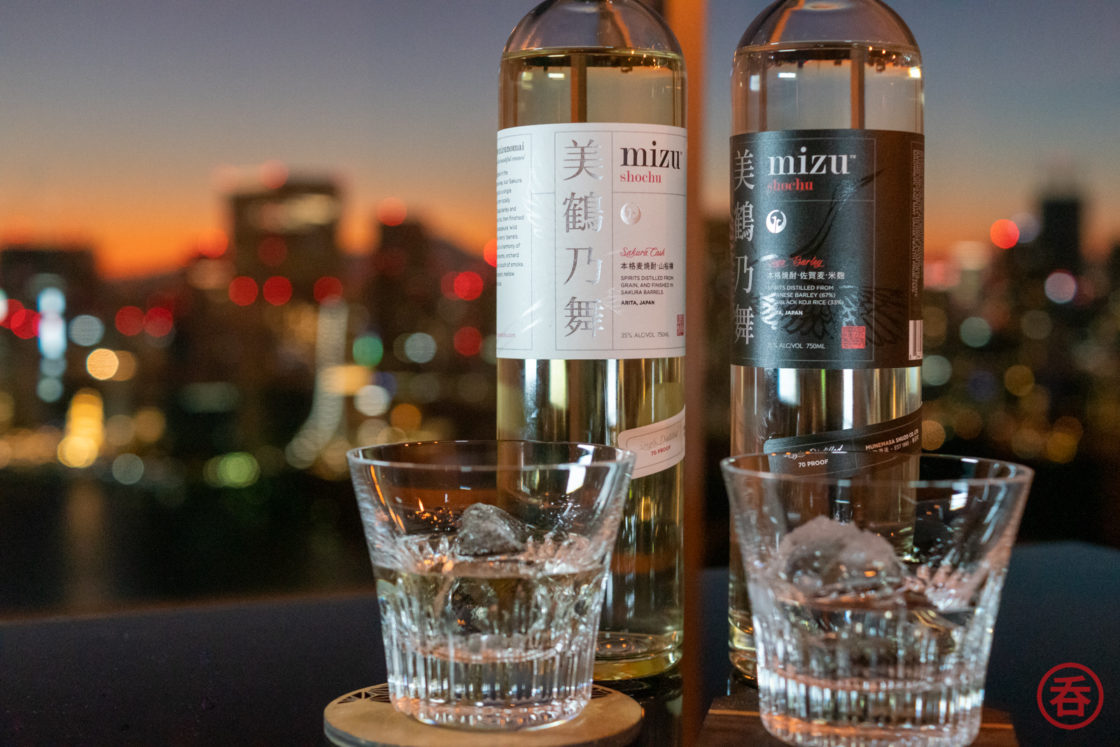Mizu Shochu is a brand of shochu launched in the US back in 2013 by Nehan Spirits (nehan is Japanese for nirvana). That’s right, a brand of shochu first launched in the US. Distribution has since expanded outside of the country, including “back home” here in Japan. Tonight we sit down with bottles of Saga Barley and the company’s newest expression, Sakura Cask.
Mizu Shochu is distilled by Munemasa Syuzo in Saga prefecture’s Arita. Arita is probably a name familiar to Suntory whisky fans as the company famously released several super-duper-premium versions of Hibiki in Arita ware bottles.Unlike the 25% standard for shochu in Japan, all of Mizu’s releases are bottled at 35% abv because this abv worked best, and it’s a more solid base for cocktails. Higher proof releases are becoming industry standard for shochu makers for international markets. Meanwhile, Mizu Shochu has been doing it since 2013.
Apart from Saga Barley and Sakura Cask, Mizu Shochu also comes in Green Tea and Lemongrass varieties. I’ll point you to kanpai.us’s reviews of those two bottles. Lemongrass technically isn’t an allowed ingredient in honkaku shochu, disqualifying that bottle from being labeled as such. But if the government permits ingredients like onions and even non-botanicals like whey for the category, I don’t see why lemongrass shouldn’t be included.
Also, shochu makers across Japan looking to export for salvation ought to take some notes about the label and bottle design here. Mizu Shochu stands out on a back bar, and it’s a bottle just asking to be asked about by your patrons.
But looks can be deceiving. Let’s find out if the contents also deliver.
Review: Mizu Saga Barley Shochu
As the name indicates, Saga Barley uses two-row barley grown entirely in Saga prefecture. Even the rice used to start the black koji is from Saga. It’s also made using water from the Kurokamiyama. The surrounding forest is one of 100 water sources selected by Japan’s Ministry of Agriculture, Forestry and Fisheries as having been protected by its local community for centuries.
Digging deeper than the marketing, you might ask how Mizu Saga Barley Shochu is different from Munemasa Syuzo’s Kuro Izumiyama or Nonnnoko Kuro releases, both also barley shochus made with black koji. And they cost about a third of what Mizu Saga Barley Shochu does. The answer is probably the abv–25% for either of those bottles vs. Mizu’s 35%–and availability outside of Japan.
Let’s dig in.
Nose: Clean and light. Earthy, grassy, with cereal, banana, unripened pear, then green apple,
Palate: Dry and light on the tongue, with subtle vanilla and more green fruits, Umami warmth of koji.
Finish: Short and simple, with trailing grain
Score: B
Price paid: Free, thanks to Nehan Spirits for providing the sample. Mizu Saga Barley retails for $34.99 in the US or 3,300 yen in Japan. 700ml, 35% abv.
Overall, an excellent example of the subtleties of barley shochu, amped up a bit for foreign audiences. I’d say it’s a bit too powerful to go alongside food, as is standard for shochu here in Japan. That said, it’s a beautiful introduction to the category for first-time shochu drinkers.
Review: Mizu Sakura Cask Shochu
Sakura Cask builds upon Saga Barley, where the same distillate is aged nine months in medium-char yamazakura casks made by famed cooperage Ariake Sangyo. It’s nine months because, any longer, you probably can’t call it shochu anymore.
Given those regulations, aging in wood hasn’t been a traditional part of shochu culture. And while this isn’t the world’s first sakura cask shochu–here’s a different one from Oita–it’s a rare combination. This kind of innovation in shochu is coming from an American company tells you a lot about how traditions could be standing in the way of proper global expansion for the category.
Sakura casks are rare for Japanese whisky, too, though some producers are experimenting with them.
Nose: Relaxing, clean, and light again, this time with fresh-cut grass, You might expect a cherry bomb, but it’s not here. The banana of the Saga Barley returns too.
Palate: And there’s the cherry we were expecting. Not the candied kind, but the ones you pick from the tree yourself.
Finish: Oaky, alongside slight cherry notes. Medium length.
Score: A-
Price paid: Free, thanks to Nehan Spirits for providing the sample. Mizu Sakura Cask Shochu retails for $54.99 in the US, and it’s not yet available in Japan. 700ml, 35% abv.
Legal classifications aside, I could ask for a bit longer in the cask on this one. With the nuances of the sakura cask, it’s pretty adventurous and the kind of shochu I think overseas audiences will appreciate more than domestic audiences.
Thanks to Nehan Spirits for the samples. I am looking forward to more of their releases!
Hi there! I created and run nomunication.jp. I’ve lived in Tokyo since 2008, and I am a certified Shochu Kikisake-shi/Shochu Sommelier (焼酎唎酒師), Cocktail Professor (カクテル検定1級), and I hold Whisky Kentei Levels 3 and JW (ウイスキー検定3級・JW級). I also sit on the Executive Committees for the Tokyo Whisky & Spirits Competition and Japanese Whisky Day. Click here for more details about me and this site. Kampai!

